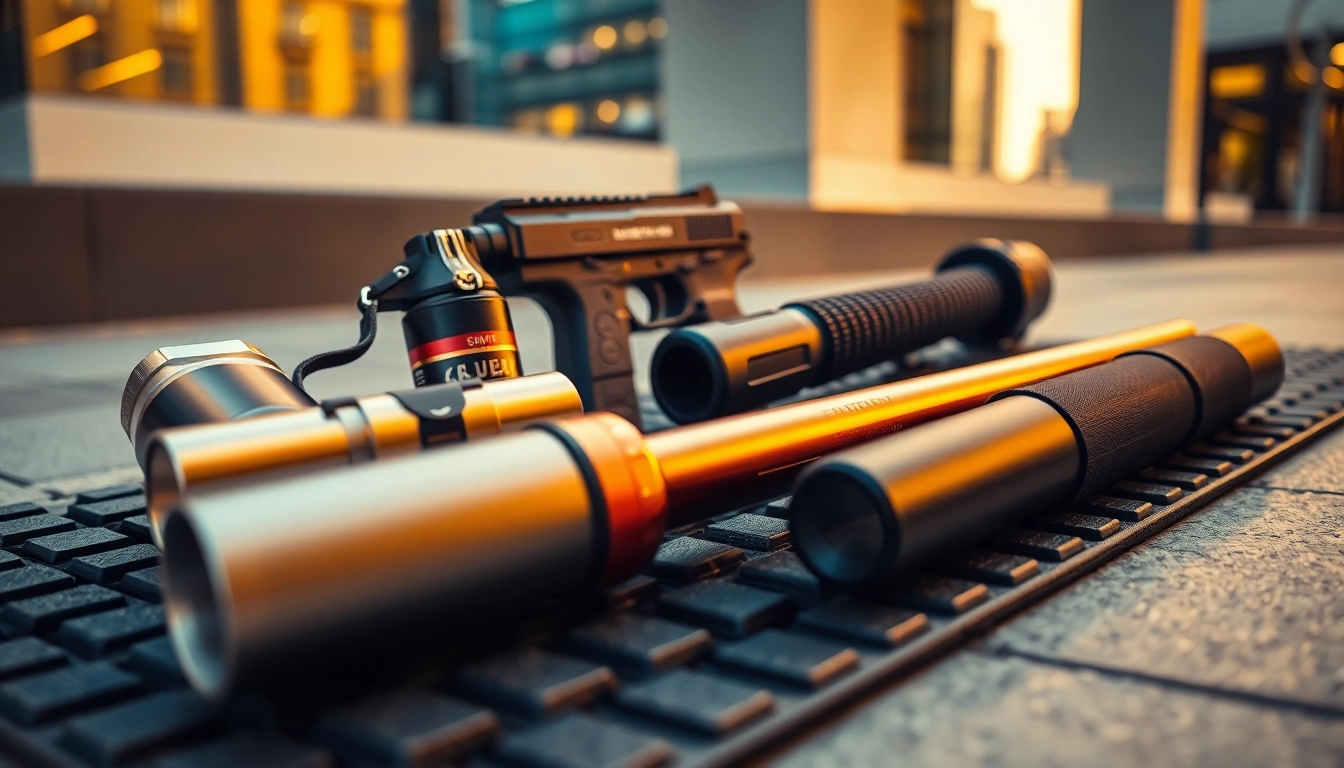Understanding Self-Defense Weapons: Types and Legal Considerations
In an era where personal safety is increasingly prioritized, understanding the landscape of self-defense weapons is essential. Whether you are walking alone at night, commuting through unfamiliar areas, or simply wanting to enhance your home security, selecting the right self-defense tools can make a significant difference. Self-defense weapons encompass a broad spectrum of devices and tactics designed to incapacitate or deter an attacker while minimizing the risk of serious injury or legal repercussions. These tools range from non-lethal options like pepper spray and personal alarms to more assertive measures such as stun guns and specialized knives.
Self-Defense Weapons are legal in many jurisdictions—though regulations vary significantly—making it crucial to understand local laws before purchasing or carrying any device. This comprehensive guide explores the various types of self-defense weapons, their legal considerations across different states and countries, and how to choose the best option tailored to your needs.
Non-Lethal vs. Lethal Self-Defense Weapons
Non-Lethal Self-Defense Weapons
Non-lethal self-defense weapons are designed to incapacitate an attacker temporarily or to create a distraction, allowing you to escape without causing permanent harm. These tools are generally preferred by civilians and individuals seeking legally safe options that minimize legal risks in case of accidental injury.
Key examples include pepper spray or mace, stun guns, personal alarms, and tactical flashlights that double as self-defense tools. These devices are often lightweight, easy to carry, and require minimal training to deploy effectively. For instance, pepper spray causes temporary blindness, difficulty breathing, and intense discomfort, which can be enough to deter an attacker and allow safe retreat.
Non-lethal weapons are particularly suitable for women, seniors, and individuals in urban environments, where the risk of criminal assault is higher. According to recent data, nearly 70% of self-defense tool buyers prioritize non-lethal options due to safety and legal considerations.
Lethal Self-Defense Weapons
Lethal self-defense weapons include firearms, knives, and other tools capable of causing permanent injury or death. While these may provide a sense of security for some individuals, their use involves significant legal and safety responsibilities. In many states and countries, carrying a firearm requires permits, background checks, and adherence to strict regulations.
Despite their effectiveness, lethal weapons are often accompanied by higher risk of legal prosecution in cases of misuse or misunderstanding. For example, concealed carry permits for handguns are required in most U.S. states, and the use of deadly force is generally only justified when faced with an imminent threat of death or serious injury.
It is critical that anyone considering lethal self-defense tools consult legal experts and undergo proper training. The National Self-Defense And Firearm Safety Association emphasizes responsible ownership and emphasizes that lethal weapons should be a last resort, deployed only when all other options have been exhausted.
Legal Regulations by State and Country
The legality of self-defense weapons varies widely depending on jurisdiction. In the United States, each state sets its own rules regarding what weapons are legal to carry, possess, or use for self-defense. For example, pepper spray is generally legal in most states, but some places impose restrictions on size or concentration. Conversely, certain types of knives, such as switchblades, may be prohibited.
Stun guns and Tasers are considered non-lethal but are not legal everywhere; some cities, like New York and certain parts of California, restrict orbanst the possession of these devices without permits. Firearms follow the most stringent regulations, with some states allowing open or concealed carry, and others requiring extensive background checks and licensing.
Internationally, laws can be even more restrictive. In countries like the UK and Australia, many self-defense weapons are classified as prohibited weapons, and carrying them can lead to criminal charges. Conversely, in Canada and parts of Europe, Legal self-defense tools such as pepper spray are regulated but permissible under specific conditions.
To navigate this complex legal landscape, it is advisable to consult local law enforcement or legal resources. Websites such as [Krav Maga UK] provide valuable information on what you can legally carry for self-defense in different regions.
Choosing the Right Self-Defense Weapon for Your Needs
Assessing Personal Risk and Environment
Selecting an appropriate self-defense weapon requires understanding your personal environment, lifestyle, and comfort level. Urban residents may prioritize discreet and easily portable devices like pepper spray or personal alarms. College students and young professionals might prefer compact stun guns or tactical keychains, which blend seamlessly into everyday carry.
Seniors or individuals with mobility issues might opt for more accessible options such as canes with hidden blades or neck knives. For those living in rural or isolated areas, a firearm might be considered, but only after thorough training and legal compliance.
Factors to Consider
- Legal compliance: Ensure the device is legal in your jurisdiction.
- Ease of use: Choose a weapon that you can deploy confidently under stress.
- Portability: Lightweight and compact devices are easier to carry discreetly.
- Effectiveness: The weapon should be capable of incapacitating an attacker quickly.
- Training requirements: Determine if additional instruction is necessary to use the tool safely.
Expert Tips
Invest in ongoing training for your chosen self-defense weapon. Many community centers and security schools offer classes for pepper spray use, stun gun operation, and self-defense tactics. Regular practice ensures that you can deploy your tools instinctively in moments of crisis.
Moreover, combining self-defense weapons with situational awareness education significantly enhances safety. Recognizing threats early, maintaining a safe distance, and avoiding risky environments are crucial components of a comprehensive personal safety strategy.
Top Self-Defense Weapons for Personal Safety
Pepper Spray and Chemical Defense Tools
Pepper spray remains one of the most popular self-defense tools due to its simplicity, legality, and effectiveness. It contains oleoresin capsicum, derived from hot peppers, which causes burning pain, eye closure, and respiratory difficulty in attackers. Modern pepper spray containers are often compact, keychain-sized, or easily accessible in a purse or pocket.
When choosing pepper spray, consider factors like spray range, potency, and safety features such as flip-top safety caps to prevent accidental discharge. Brands like Byrna offer non-lethal, legal pepper spray options with extended reach and high-quality aerosolization.
Stun Guns and Tasers: Electric Shock Devices
Stun guns and Tasers deliver an electric shock that temporarily disables an attacker by disrupting their neuromuscular function. These are highly effective in close-range situations and are legal in many states when used responsibly. Modern stun guns often combine with flashlight features, enhancing their utility.
Proper training ensures quick deployment and safe handling. With ranges up to several feet, Tasers are also favored by law enforcement agencies and security professionals. When considering a stun device, ensure compliance with local laws, as some regions require permits.
Discreet Weapons: Keychains, Pens, and Canes
Discreet self-defense tools are designed to blend seamlessly into daily life. Items like tactical keychains, disguised pens, or canes with hidden blades are effective for individuals seeking non-obvious protection. These tools often serve multiple purposes—functional and self-defense—thus encouraging regular carry.
For example, a sturdy cane equipped with a hidden metal spike can be a lifesaver, especially for seniors or those with mobility aids. Such devices should be selected for ease of use, durability, and legal compliance.
Strategies for Effective Use of Self-Defense Weapons
Proper Training and Safety Tips
The effectiveness of your self-defense weapon hinges on proper training. Understanding how and when to deploy your device can make the difference between safety and escalation. Enroll in self-defense classes that include hands-on practice with pepper sprays, stun guns, or other gadgets.
Safety precautions are equally important. Always keep your self-defense tools in accessible locations, check their functionality regularly, and familiarize yourself with their operation. Avoid reckless deployment, and remember that your primary goal is to create an opportunity to escape.
Situational Awareness and De-escalation
No weapon can substitute for awareness. Paying attention to your surroundings, trusting your instincts, and avoiding risky situations can prevent many threats altogether. If confrontation seems inevitable, attempt verbal de-escalation. Use a confident, assertive voice, and attempt to create distance.
Remember, a self-defense weapon should be your last line of defense—use it only if verbal warnings or escape routes are ineffective.
Maintaining Accessibility and Readiness
Regularly review where you carry your self-defense tools. Use dedicated holsters, keychain cases, or purse compartments designed for quick access. Ensure devices are charged (for electronic devices) and in working condition. Practicing quick retrieval during drills can build muscle memory, helping you respond efficiently under stress.
Additionally, keep your tools up-to-date, replacing expired pepper spray or worn-out batteries in electronic alarms.
Innovative and Legal Self-Defense Products for Women and Men
Stylish and Compact Self-Defense Devices
Modern self-defense devices are increasingly designed with aesthetics in mind. Ladies’ stun guns, chic pepper spray cases, and fashionable personal alarms combine safety with style. These products allow users to carry protective items comfortably without drawing unwanted attention.
For women, brands like Defense Divas® offer elegant, discreet tools that blend into daily fashion, encouraging regular carry. Men can opt for rugged yet compact devices that fit into pockets or belt holsters.
Home and Personal Protection Kits
Comprehensive self-defense kits include multiple devices suited for various scenarios, such as door alarms, window sensors, pepper spray, and stun guns. Assembled properly, they provide layered protection for the home and on-the-go safety.
For instance, a kit comprising a portable pepper spray, doorstop alarm, and personal safety whistle provides versatility and reassurance, especially in vulnerable settings like parking lots, garages, or hotel rooms.
Smart Devices and Personal Alarms
The advent of smart personal safety devices has revolutionized self-defense. Connected alarms, GPS trackers, and smartphone-compatible pepper sprays enable real-time alerts to emergency contacts. Devices like Byrna’s non-lethal launchers combine traditional self-defense with modern technology, enhancing safety while remaining legal and non-lethal.
Investing in such smart options can significantly improve response times and provide peace of mind, especially for solo travelers and students.
Best Practices for Purchasing and Carrying Self-Defense Weapons
Where to Buy Reliable Self-Defense Weapons
Quality and legality are paramount when purchasing self-defense weapons. Reputable outlets include licensed physical stores and verified online retailers. Websites like BUDK and specialized security stores offer a curated selection of tested, legal devices designed for public purchase.
Always verify seller credentials, read reviews, and opt for products with clear product descriptions, safety features, and legal compliance certifications.
Ensuring Compliance with Local Laws
Before acquiring any self-defense tool, research your local laws thoroughly. Many states have restrictions on types, sizes, and carrying methods of devices like stun guns or knives. Some areas require permits or registration.
Use official legal resources or consult local law enforcement to confirm the legality of your chosen devices. Remember, ignorance of the law is not a defense—non-compliance can lead to confiscation, fines, or criminal charges.
Practical Tips for Discreet and Secure Carry
Carrying your self-defense tools discreetly ensures their accessibility and reduces the risk of theft or accidental discharge. Use concealed carry holsters, compact cases, or integrated accessories designed for your device.
Practice retrieving your tools confidently and without hesitation. Label your devices clearly and prioritize safety—disable electronic alarms or stun guns when not in use to prevent accidental activation.









